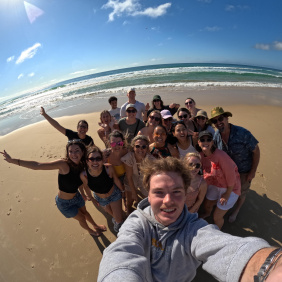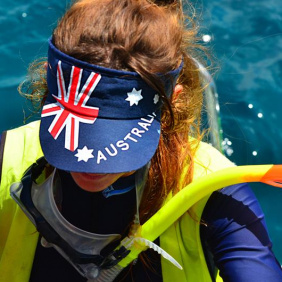Image thanks to Tracy’s Travels in Time
Australia is famous for trying to kill you. With its harsh environments the wildlife of the relatively isolated country was able to evolve independently of the rest of the world and were able to uniquely adapt to Australia’s environment. Today Australia has some of the most unique wildlife in the world. About 90% of the mammals, 70% of the birds, 88% of the reptiles and 94% of the frogs are found nowhere else on earth but Australia. So when it comes to the weird, wild and wonderful, Australia’s got you covered. Here are some of Australia’s weirdest animals.
Platypus
Image thanks to the ABC
The Platypus is by far one of the world's weirdest animals. An Australian chimera, with the bill of duck, tail, and fur of a beaver and the feet of an otter, it was so bizarre that the first scientists that examined a preserved platypus thought it was a fake and made of several animals together. This semi-aquatic animal is one of only five monotremes (with the others being four species of echidna), the only class of mammal that lays eggs instead of giving birth to live young. The Platypus is also one of the few rare animals to have the sense of electroreception - a sense that enables them to locate there by detecting electric fields generated by tiny muscular contractions. And that’s not all, the males tout venomous ankle spurs on their back legs as a means of defence.
Tasmanian Devil
Image thanks to Fodors Travel Guide
The Tasmanian Devil earned its name from when early European settlers heard mysterious otherworldly screams, coughs and growls deep in the Tasmanian bush that they thought could have only come from the devil himself. After searching further they discovered this dog-like creature with red ears and wide jaws and big sharp teeth, all features that earned it the name devil. The Tasmanian Devil’s bite is actually much worse than it’s bite. The Devil’s bite is one of the most powerful bites relative to body size of any living mammalian carnivore, allowing it to take on creatures up to 4 times its size. Although they go by the name ‘Devil’, Tasmanian Devils are actually pretty docile and quiet creatures when it comes to humans. If you ever encounter one they’ll either run away or growl and Tasmanian Devil Attacks are rare.
Unfortunately, the Tasmanian Devil population is steadily decreasing due to a contagious cancer that goes by the name of Devil Facial Tumour Disease (DFTD). However, things are looking up due to plenty of conservation efforts around Australia making positive steps towards a vaccine.
Echidna
Image thanks to Animals Network
Another of Australia’s awesome monotremes. The Echidna is really the anteater of Australia. It has no teeth and it eats mostly ants and termites, catching, and then grinding them up with its long tongue. While the spikes make the Echidna look like a fearsome animal they’re shy and would rather retreat than fight. Meaning you’re unlikely to see one in the wild. In the event it’s frightened or needs to defend itself it will curl into a ball, wedge itself beneath rocks or burrow down in order to make the best use of its spikes. Interestingly the spikes themselves are actually hollow hairs. The Echidna also hosts the Bradiopsylla echidnae, aka the Echidna flea, which is thought to be the world's largest flea reaching up to 4 millimeters in length.
Tree Kangaroo
Image thanks to ZooBorns
Australia is home to two types of Tree Kangaroo, the Lumholtz Tree Kangaroo and Bennett’s Tree Kangaroo. Both of these are very rare and actually the only true arboreal (they live in trees) macropods, a family of marsupials that also includes kangaroos, wallabies, and quokkas. Although they’re considered extremely hard to find, if you do want to go searching for one, both species live in the treetops of far north Queensland, mostly taking up space in the Daintree Rainforest.
The Tree Kangaroo is unfortunately yet another species being affected by changing environments. With drier environments the rainforests trees they live in, and the leaves they eat off of those trees are getting less water. This means there’s a higher concentration of toxins in those leaves and has started to lead to blindness in some of these animals.
Giant Panda Snail
Image thanks to Catalogue of Organisms
Larger than a tennis ball, the Giant Panda Snail lives up to its name of giant by being Australia’s biggest species of land snail. Living along subtropical eastern Australia (you can find these guys around places like Smiths Lake in NSW.) the snail is mostly nocturnal, spending the day hiding under rotten logs and leaf litter. But once the night is dark and the moon is out the Giant Panda Snail gets on the move, heading in no particular direction, in order to find some dinner. The snail is a fungivore, feeding on mushrooms and fungi in the surrounding area, as well as rotting leaves on the forest floor. Like most snails the Giant Panda Snail is a hermaphrodite, meaning it can be either male or female at any given time.
Cassowary
Image thanks to Geek.com
This is the mascot of the old adage “everything in Australia is trying to kill you.” While they may look like the emu’s tropical cousin they’re barely related - more like a 10th cousin 3 times removed. Instead, they’re more of a close relative to the velociraptor.
These giant rainbow chickens mostly live in tropical North Queensland, (especially in places like the Daintree Rainforest) but can also be found dotted about Australia. The Cassowary is a big bird, in fact it’s the second biggest, beating out its very distant cousin the Emu but just losing out to the Ostrich. While it’s mostly known for looking out of this world, the Cassowary is also known for one more thing, being incredibly dangerous.
The Cassowary is very wary of humans and the general rule is if you leave them alone they’ll leave you alone. But if provoked they’re capable of inflicting serious injuries. Being one of the only types of birds to have killed humans it’s been called “the world’s most dangerous bird”. But why is the Cassowary so dangerous? Well they’re basically the terminator of the bird world. The Cassowary has incredibly sharp claws, the middle being much like a dagger. The Cassowary can also run up to 50km/h, jump up to 1.5m and even swim. If provoked they’ll chase down the provoker, and jump and either attempt to kick the person with their sharp claws, headbutt them with their hard horn or peck with it’s sharp beak.
Lord Howe Island Stick Insect
Image thanks to The Conversation
The Lord Howe Island Stick Insect is perhaps one of the rarest insects in the world. This critically endangered species inhabits Ball’s Pyramid, a jagged, inhospitable mountain of rock jutting out of the pacific ocean. It’s actually one of the above-ground remnants of the once lost sunken continent of Zealandia. The Lord Howe Island Stick Insects were once quite common but were soon believed to be extinct after a ship carrying black rats ran aground on the island in 1918. However, in 2001 they were rediscovered in a small outcrop and only 20-30 are left.
Mount Kaputar Giant Pink Slugs
Image thanks to Sydney Morning Herald
Just recently discovered in 2018, this hot pink slimy slug lives on the top of an extinct volcano. Initially they were thought to be a variety of red triangle slug - an interesting animal in its own right - that’s common across the Australian east coast, but were found to be completely unique and only inhabits this small 10sq.km patch of land, 1500m above sea level.
The slug is roughly the length of a paperback book, about 20cm, and about 4-6cm wide. They’re so big because with an abundance of food and lack of predators they can evolve to be as big as they want. That goes for their fluorescent pink colouring as well. Because you can be any colour you like when there’s no one to bother you.
Unfortunately most of these amazing animals are threatened species. Be it threats from changes in environment, human interference, invasive species, or something we don’t even know about yet, the populations of many of these beautiful animals (we’re even talking about you Giant Pink Slug) are shrinking.
If you care about any of these one-of-a-kind creatures the best way you can help is by skipping the morning coffee or passing up on one late night drink and donating to the Australian Wildlife Conservancy who work hard to track and maintain the populations of Australia’s unique wildlife.



